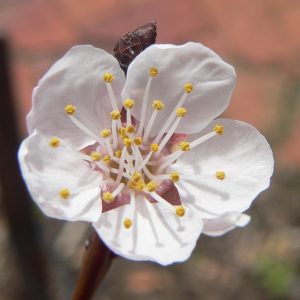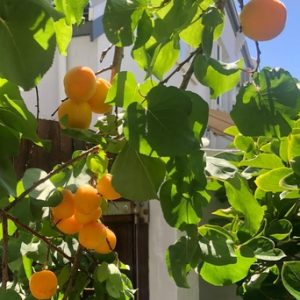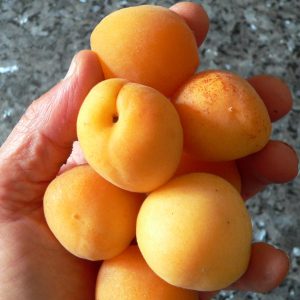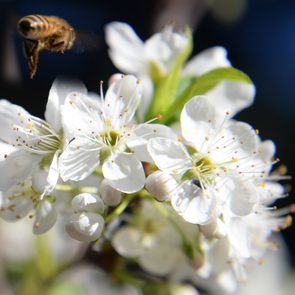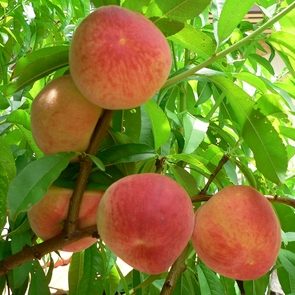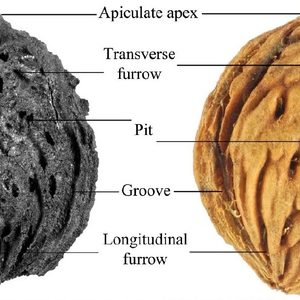Prunus spp
Apricots, Nectarines, Peaches, Plums, Stone Fruit
An outline is given for the sub-tropical members of this large group, namely apricots (P. armeniaca), peaches and nectarines (P. persica) and Japanese plums (P. salicina), abbreviated as AP, PN and PL respectively, as opposed to the more temperate zone fruits such as cherries and European plums.
Origin
All native to China.
Climate
Best grown where summers are warm and dry and the hazard of spring frosts is low. They do not tolerate waterlogging but have some tolerance of drought. Coastal Perth areas get about 300 chill hours each year, so varieties selected should have chill requirements below this level to flower and fruit successfully.
Plant Description
They are all small deciduous bushy trees, 4- 8m high. PN leaves are deep green, long and thin, PL mid-green, elliptic and AP mid-green, broadly oval.
Relatives
Rosaceae Family. There are hundreds of fruit tree species in the genus Prunus, plus also many inter-specific hybrids eg plumcots.
Soils
Prefer light deep soils with good drainage. Avoid heavy clays and wet soils
Propagation
Mainly by budding. AP and PN seedlings are commonly used as rootstocks, and dwarfing rootstocks are also available.
Cultivars
Cultivar performance is very much influenced by environment, so the best strategy in selection from the many available is to choose those that are known to fruit well locally.
Flowering and Pollination
Flower buds are produced usually on one-year-old shoots, plus in AP and PL on spurs on older wood. The individual hermaphrodite flowers all have 5 sepals, 5 petals, numerous stamens and a single carpel. In spring, flower buds open first followed by leaf buds. Important PN varieties are self-fertile, AP mainly so, but most PL require cross-pollination. They are insect pollinated, usually by bees, with wind playing a small part in some.
Cultivation
All 3 species require adequate nutrition for quality fruit and yield, with PL less demanding than the other two. Adequate watering should be given during fruit growth through to maturity.
Wind Tolerance
Tolerance is moderate.
Pruning
They are most commonly grown as an open vase, so when young, 3-4 well-spaced scaffold limbs should be selected for the main framework. With mature plants, size should be limited for ease of pruning, harvesting and spraying. Each year 1 year old shoots should be shortened and thinned to encourage development of new fruiting shoots along the whole length of scaffold branches. Light penetration throughout the canopy should be maintained. In most cvs, blossom and fruit will need to be thinned.
Trees can also be espaliered, a method that is very productive in a small space, and that can more readily protect the fruit from birds with netting.
The Fruit
All produce drupaceous fruits where the edible portion consists of a fleshy exocarp and mesocarp surrounding a stony endocarp (pit or stone) containing a single seed. AP are freestone, PN free-, semi-, or clingstone, and PL is usually clingstone.
AP flesh is orange, PN white or yellow and PL yellow-dark red.
Fruit Production and Harvesting
Time to first harvest is 2-4 years, with full production of AP and PN by 4-6 and PL by 9. Best fruit flavour is attained when fruit are left to fully ripen on the tree before picking. At 0-1°C, AP will store for 1-2 weeks, PL for 2-4 and PN for up to 5.
Fruit Uses
All are eaten fresh, dried or canned and used in numerous processed forms.
Pests and Diseases
They are attacked by many pests and diseases, with drier environments leading to lower disease load. Some problems that may need to be managed are Medfly, leaf curl, shothole and birds.
Comments
In our climate, stone fruit trees need considerable management but will produce bounteous crops.
More Information
Modern era peaches go way back in time
A study published in Nature Scientific Publications (Su, T. et al. Peaches Preceded Humans: Fossil Evidence from SW China. Sci. Rep. 5, 16794; doi: 10.1038/srep16794, 2015) describes fossilised peach stones that were found in late Pliocene strata in south western China. The organic material had been largely replaced by iron oxides and their age was way beyond what radio carbon dating could establish; geological stratigraphy using a combination of lithostratigraphic correlations, paleomagnetic data and regional palynology indicated they were about 2.6 million years old. The picture shows the fossilised (L) and modern (R)) endocarps.
China is thought to be the origin of the modern peach (Prunus persica, family Rosaceae), but the oldest previous evidence for them had been Chinese archaeological records dating back to 8000-7000 BP. The eight fossilised endocarps found were identical to modern peach endocarps, including size comparable to smaller modern varieties, a single seed, a deep dorsal groove, and presence of deep pits and furrows. The study suggests that China has been a critical region for peach evolution long before human presence, much less agriculture. Peaches evolved their modern morphology under natural selection, presumably involving large, frugivorous mammals such as primates. Much later, peach size and variety increased through domestication and breeding.
Dried apricot carotenoid content
Traditional methods for extending the storage life of perishable foods such as fruit, vegetables, milk, meat and fish were based overwhelmingly on techniques available at the time, eg salting, smoking, fermentation and solar drying with little knowledge of the effects these processes had on nutritional properties. Nowadays we have a far wider range of techniques including freezing, high pressure, spray and drum drying, and vacuum and microwave drying, but the question for each remains – how do they affect healthful nutrients and are some techniques better than others? The answers vary greatly depending on what is intended, the particular fruit and cultivation conditions, its state of maturity, how pre-treatment may influence processing, storage conditions etc, so let’s just consider one example – thermal drying of apricots.
This product is commonly known and enjoyed everywhere as about half the total world crop is sold dried, usually by solar heating. Most consumers prefer them when in a çhewy rather than crisp state and this means they are processed to a moisture content that is higher than that required to totally prevent microbial spoilage. This is prevented usually by ‘sulphuring’, where either burning sulphur or bisulphite is used as a preservative. However some people are hypersensitive to the resultant SO2 and have unwanted inflammatory reactions. Plus, SO2 totally destroys vitamin B1. Leaving this as a separate issue, to what extent does the solar or hot air drying cause breakdown of valuable nutrients?
All fruits have high moisture content, usually around 90%, and as a result their nutritional qualities depend mainly on vitamins and similar acting phytonutrients, fibre type and content, and to a lesser degree, minerals. Minerals are the least affected by drying, fibre properties are changed because cellular structure is compromised as the fruit dries out, and vitamins/phytonutrients are the most sensitive to processing conditions. It should be realized that in achieving extended storage life with drying, products are subjected to longer, possibly degrading conditions, than they ever would be in the fresh state. Storage losses, due for example, to oxygen and light can then sometimes outweigh those from the processing operation itself. Most breakdown of vitamins and phytonutrients in drying occurs enzymatically or thermally, the latter often by oxidation. Pre-treatment blanching (eg 100°C for 1-3 minutes followed by rapid cooling) is one way to inactivate enzymes and minimise losses from this source.
Carotenoids are responsible for the yellow colour of many fruits and vegetables, and are a major nutritional feature of apricots. Many of these can be converted into vitamin A in the body, ie they are pro-vitamins. In an Italian study (Plant Foods & Human Nutrition, 2013, 68, 241-246) it was found that apricot halves dried in a dehydrator at 60°C or 70°C with no other pre-treatment took 21 and 15hrs respectively to reduce moisture content from 87% to 20%. Carotenoids are regarded as being relatively heat stable whereas many of the other common vitamins, vitamin C in particular, are notoriously more prone to degradation. Nevertheless, in this study carotenoids still decreased by 28 and 43% respectively compared to the fresh fruit.
In general, newer techniques such as freeze-drying lead to better nutrient retention than that obtained in hot air or sun dried products. Solar drying is still a major process in the developing world because it doesn’t involve large capital costs and it’s energy-free. But sufficient space is needed, labour is required to turn and rake fruit, processing is not well-controlled and needs warm sunny weather, fruit have to be protected from rain and over-night moisture, there can be foreign matter (eg dirt) contamination, and fruit need protection from insects, birds and microbial spoilage given the process can take several days. There is also a risk of aflatoxins being produced which are carcinogenic. In addition, it involves exposure of fruit to strong light which can cause breakdown of phytonutrients such as vitamins B2 and C. Surveys show that, on average, consumers place hedonic qualities of fruit, ie taste, flavour, aromas, appearance and texture before nutrition. And dried fruits are normally most desirable because their sweetness etc has been concentrated through loss of moisture. However, if nutrition is important to you then fresh is almost always best. Dried products do serve a valuable role in providing important out-of-season foods which can also be distributed to locations other than where they’re grown. The challenge to the modern processing industry and the home processor, is to adopt those techniques that provide the tastiest, healthiest and safest products.
